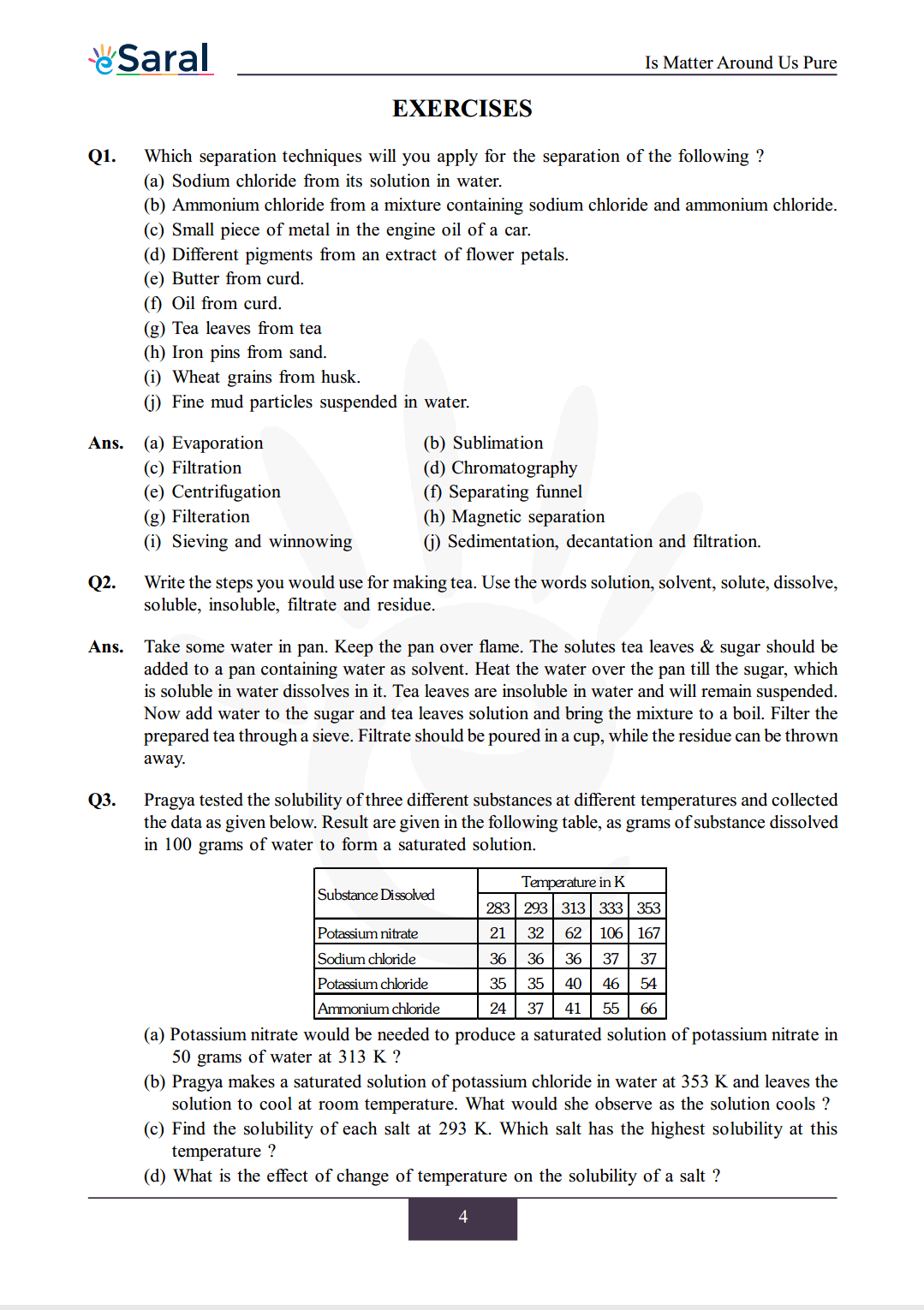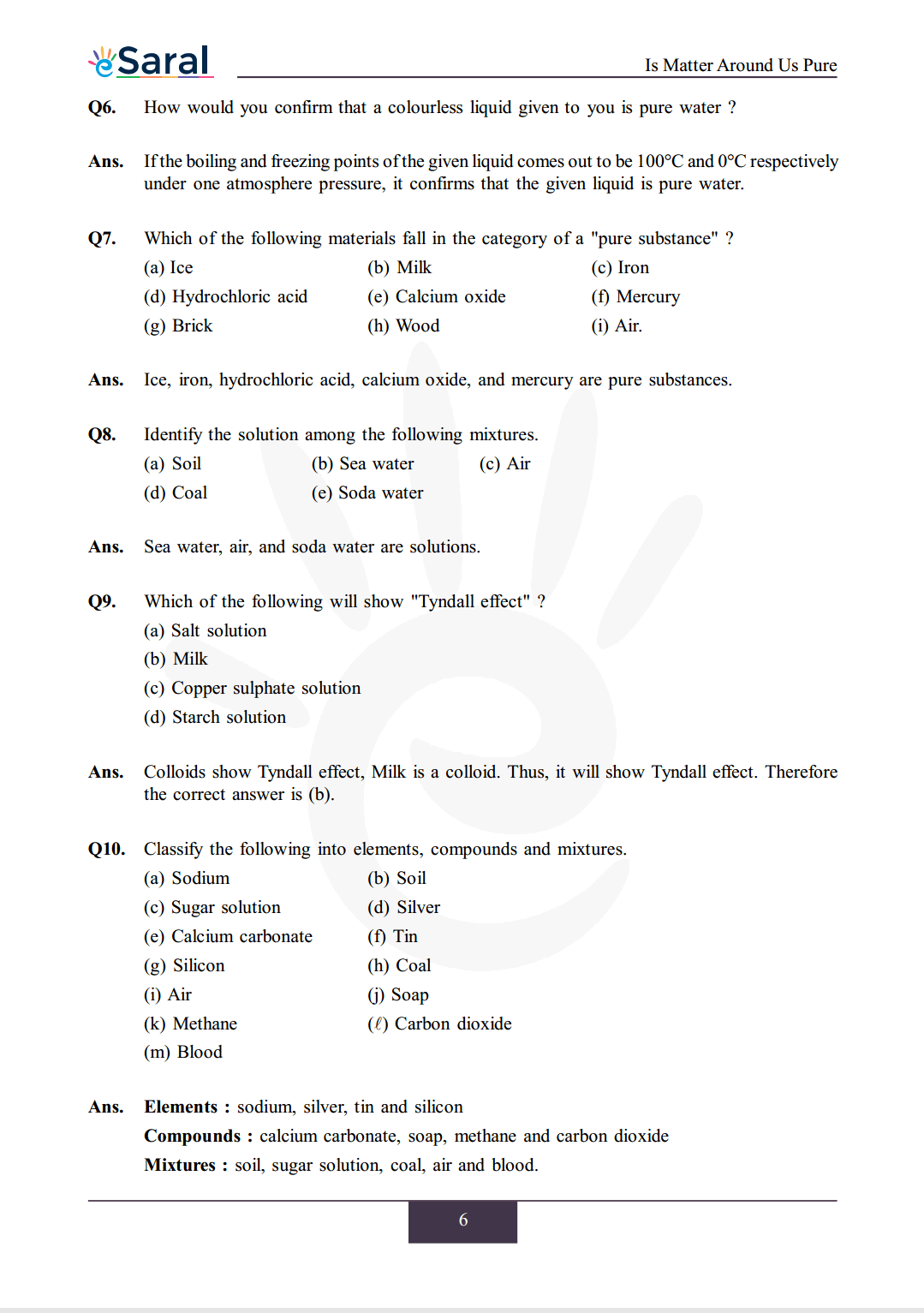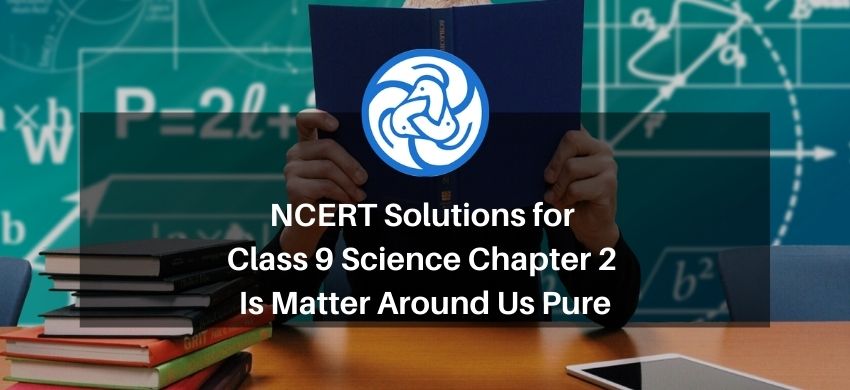
Hey, are you a class 9 student and looking for ways to download NCERT Solutions for Class 9 Science Chapter 2 "Is Matter Around Us Pure"? If yes. Then you are at the right place.
In this article, we have listed NCERT solutions for class 9 Science Chemistry Chapter 2 in PDF that is prepared by Kota’s top expert Chemistry Faculties by keeping Simplicity in mind.
If you want to learn and understand class 9 Science chapter 2 "Is Matter Around Us Pure" in an easy way then you can use these solutions PDF.
NCERT Solutions helps students to Practice important concepts of subjects easily. Class 9 Science solutions provide detailed explanations of all the NCERT exercise questions that students can use to clear their doubts instantly.
If you want to score high in your class 9 Science Exam then it is very important for you to have a good knowledge of all the important topics, so to learn and practice those topics you can use eSaral NCERT Solutions.
In this article, we have listed NCERT Solutions for Class 9 Science chapter 2 that you can download to start your preparations anytime.
So, without wasting more time Let’s start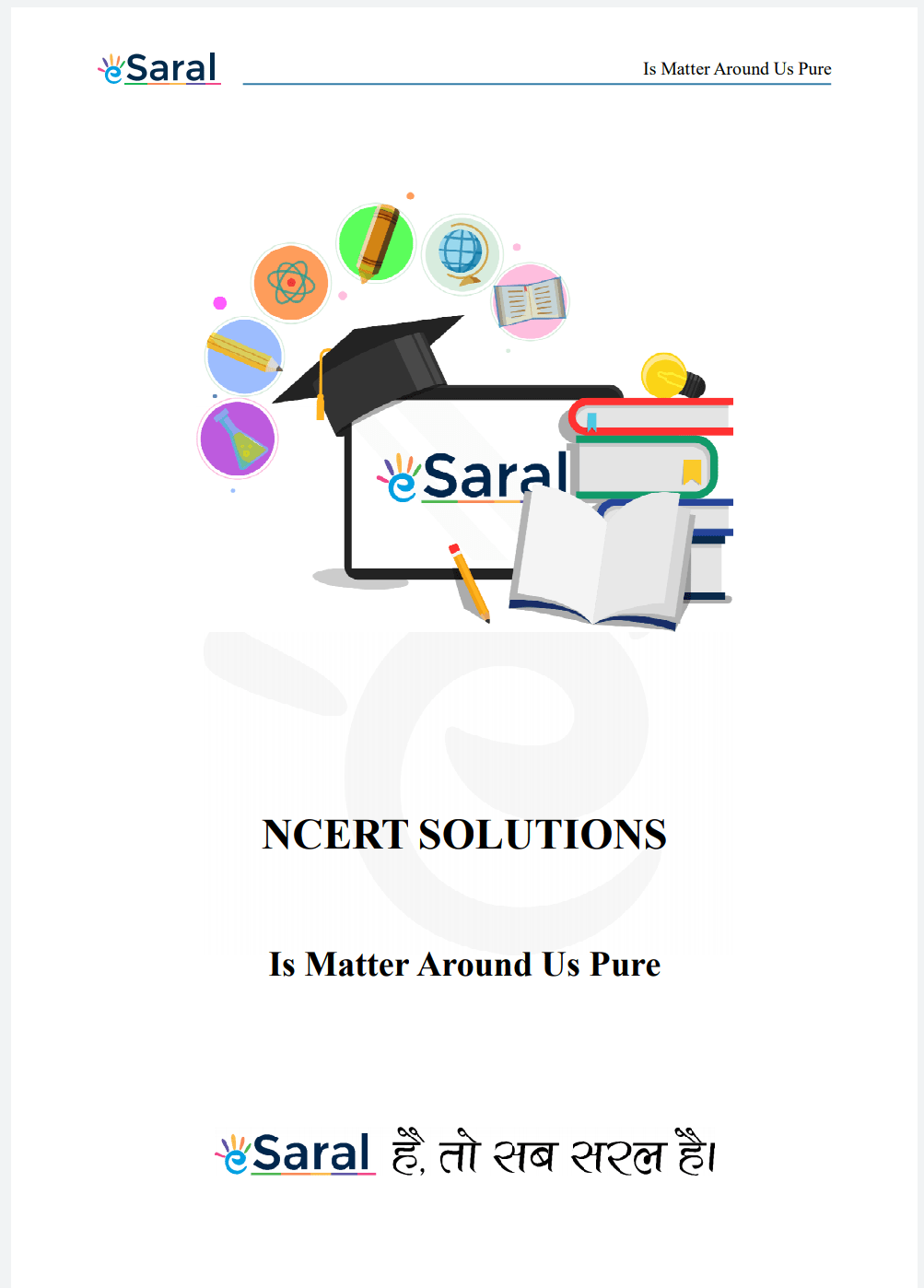
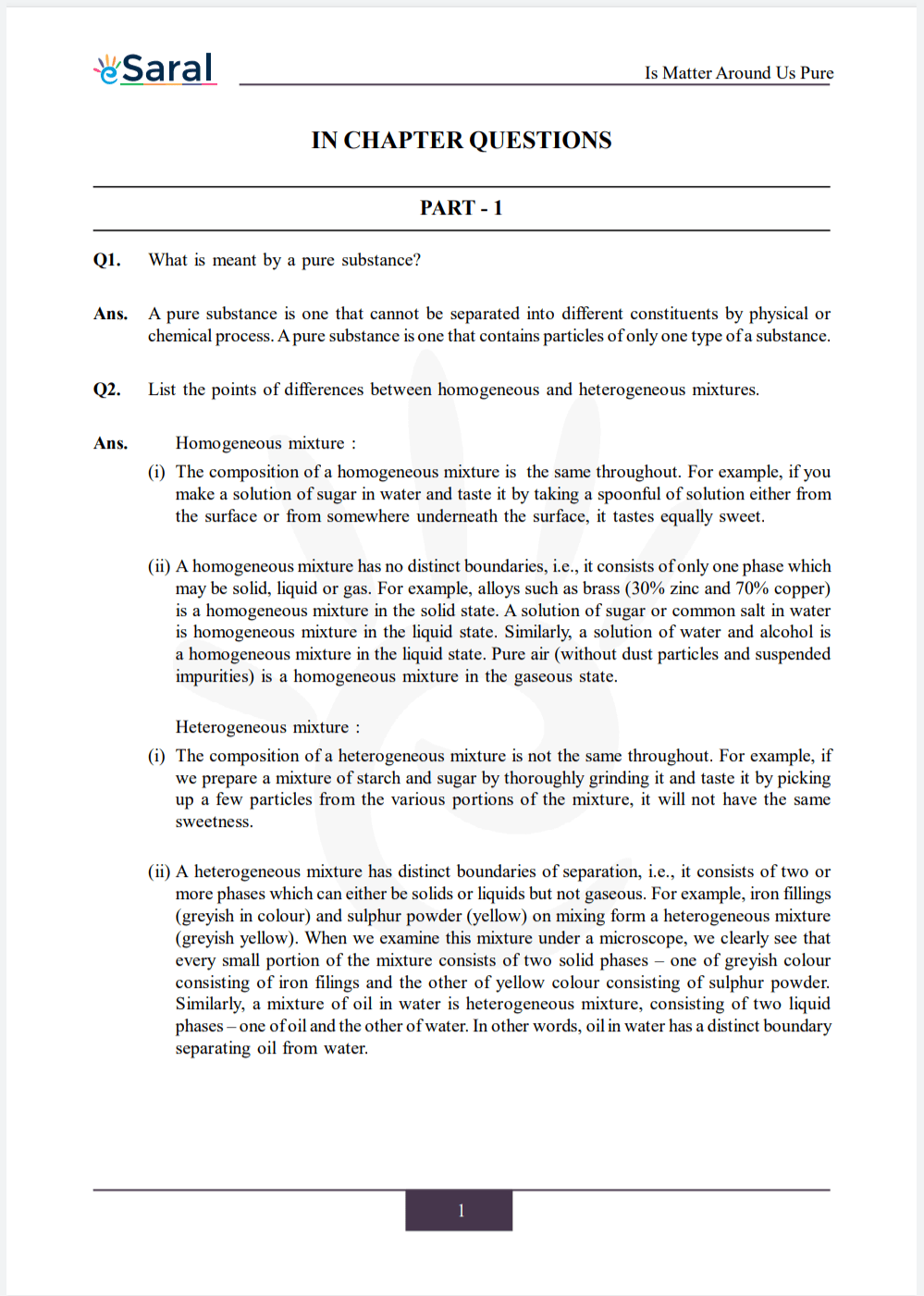
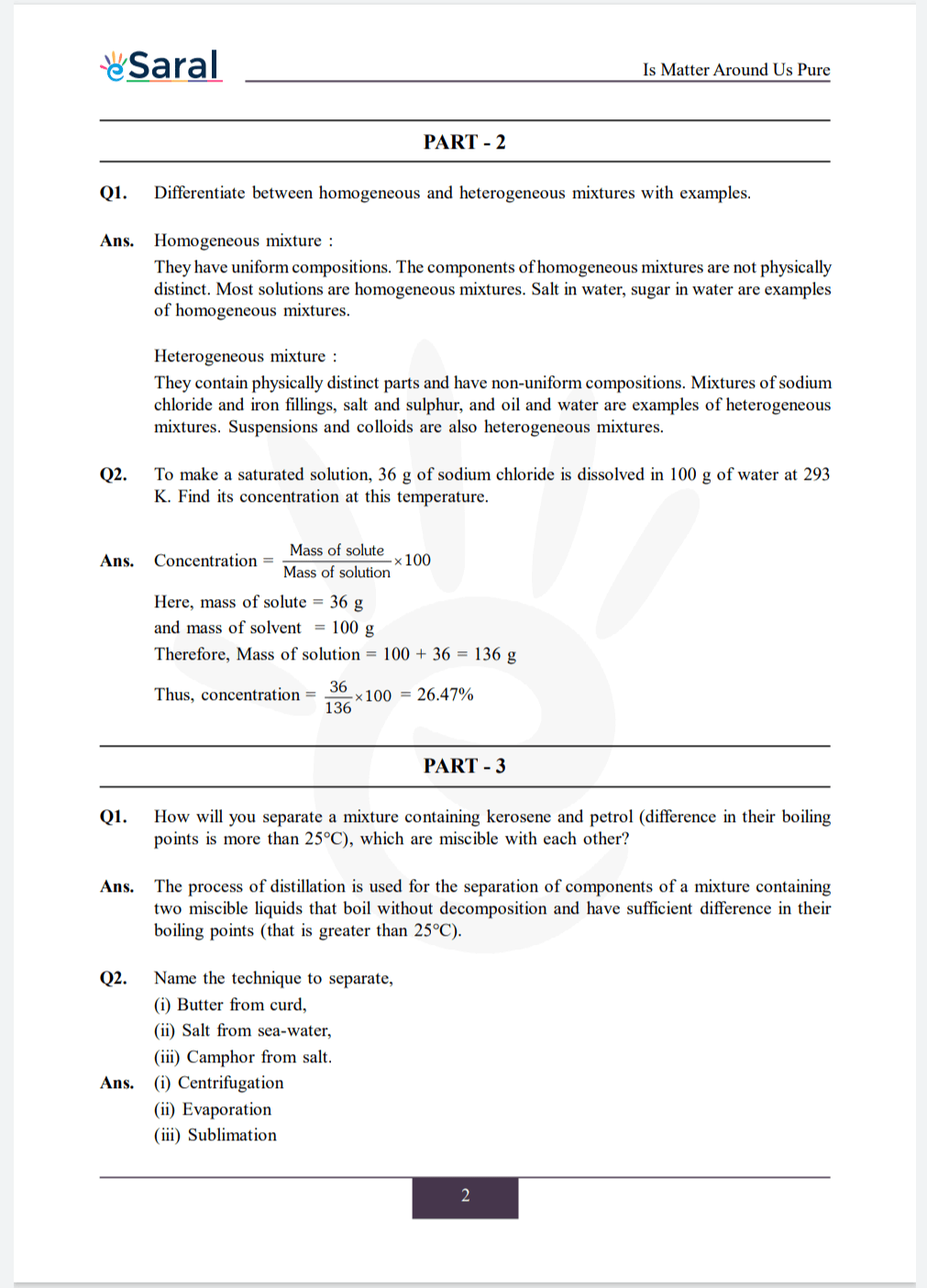
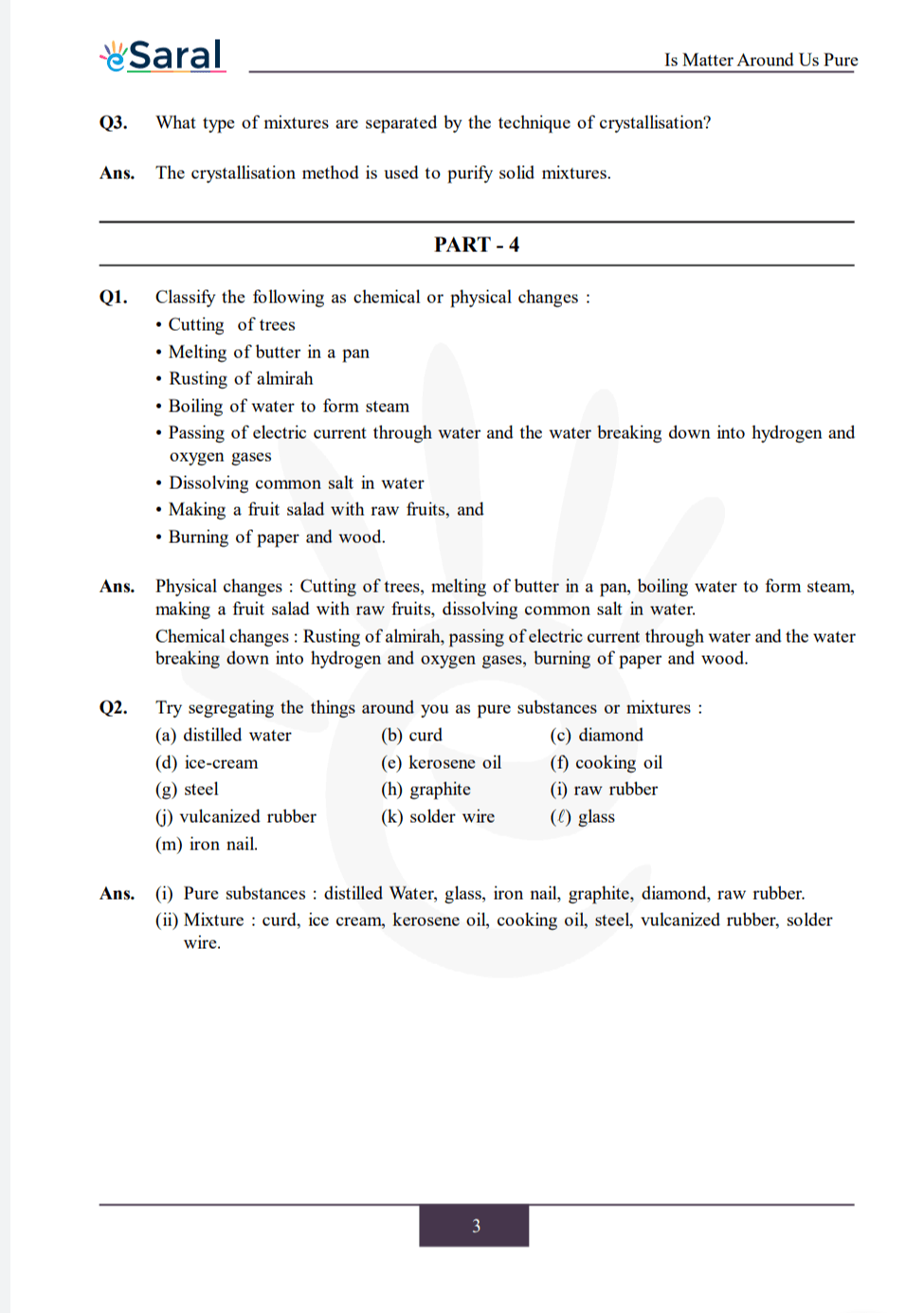
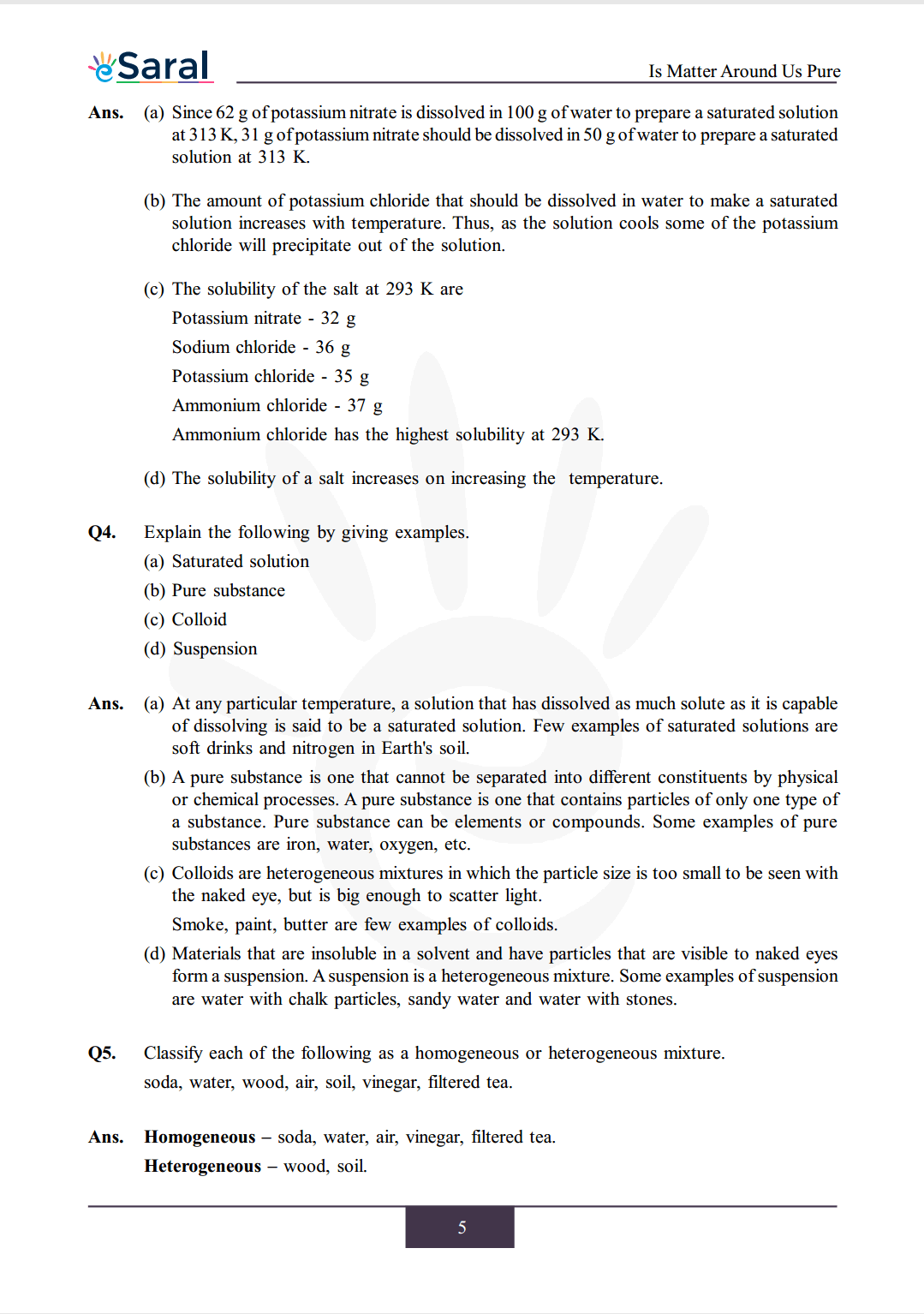
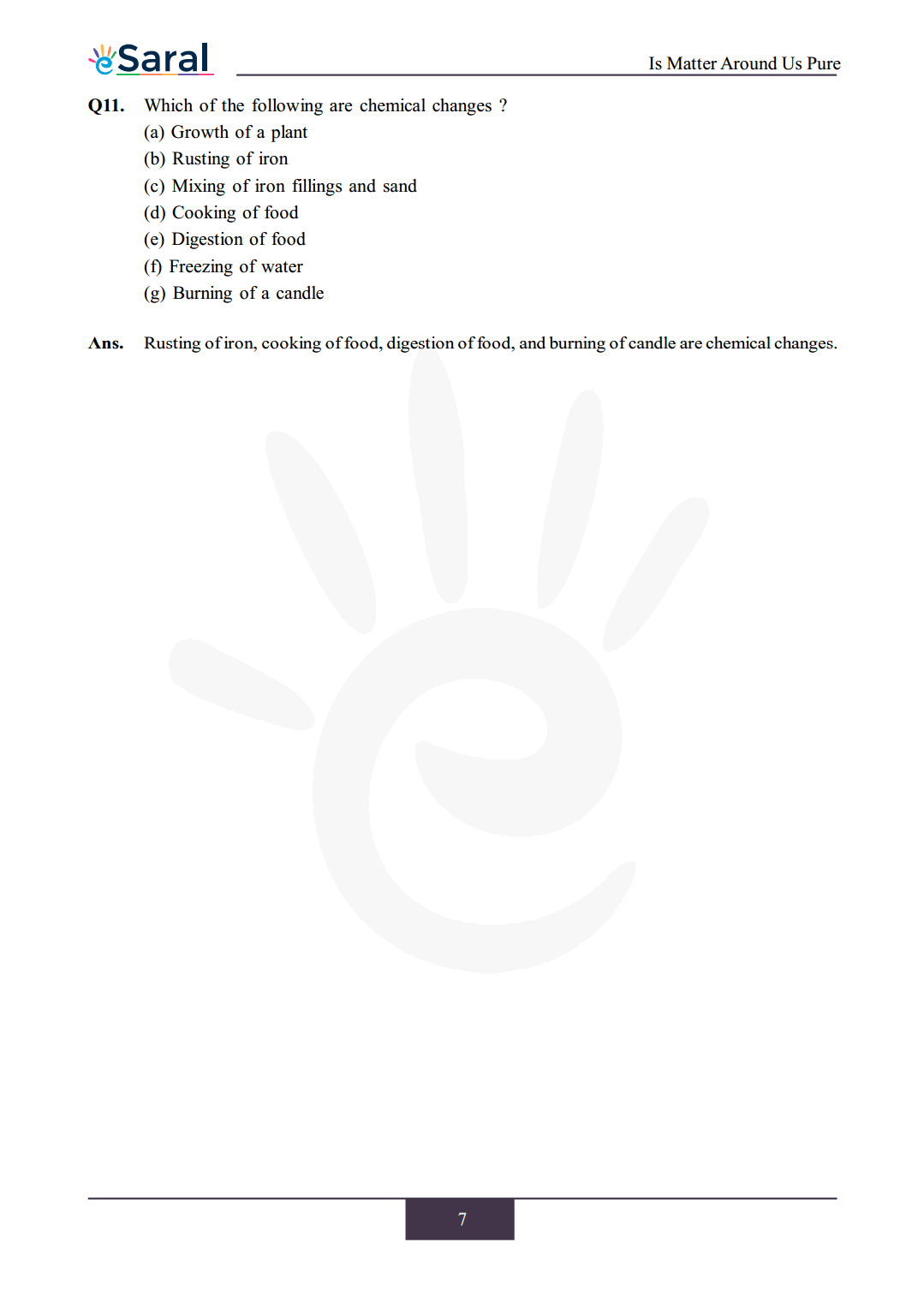
Q1. What is meant by a pure substance?
Q2. List the points of differences between homogeneous and heterogeneous mixtures.
Q1. Differentiate between homogeneous and heterogeneous mixtures with examples.
Q2. To make a saturated solution, 36 g of sodium chloride is dissolved in 100 g of water at 293
K. Find its concentration at this temperature.
Q1. How will you separate a mixture containing kerosene and petrol (difference in their boiling’ points is more than 25°C), which are miscible with each other?
Q2. Name the technique to separate,
(i) Butter from curd,
(ii) Salt from sea-water,
(iii) Camphor from salt.
Q3. What type of mixtures are separated by the technique of crystallization?
Q1. Classify the following as chemical or physical changes:
1. Cutting of trees
2. Melting of butter in a pan
3. Rusting of almirah
4. Boiling of water to form steam
5. Passing of electric current through water and the water breaking down into hydrogen and
oxygen gases
6. Dissolving common salt in water
7. Making a fruit salad with raw fruits, and
• Burning of paper and wood.
Q2. Try segregating the things around you as pure substances or mixtures:
(a) distilled water
(b) curd
(c) diamond
(d) ice-cream
(e) kerosene oil
(f) cooking oil
(g) steel (h) graphite
(i) raw rubber
(j) vulcanized rubber
(k) solder wire
(l) glass
(m) iron nail.
Q1. Which separation techniques will you apply for the separation of the following ?
(a) Sodium chloride from its solution in water.
(b) Ammonium chloride from a mixture containing sodium chloride and ammonium chloride.
(c) Small piece of metal in the engine oil of a car.
(d) Different pigments from an extract of flower petals.
(e) Butter from curd.
(f) Oil from curd.
(g) Tea leaves from tea
(h) Iron pins from sand.
(i) Wheat grains from husk.
(j) Fine mud particles suspended in water.
Q2. Write the steps you would use for making tea. Use the words solution, solvent, solute, dissolve,
soluble, insoluble, filtrate and residue.
Q3. Pragya tested the solubility of three different substances at different temperatures and collected
the data as given below. Result are given in the following table, as grams of substance dissolved
in 100 grams of water to form a saturated solution.

(a) Potassium nitrate would be needed to produce a saturated solution of potassium nitrate in
50 grams of water at 313 K ?
(b) Pragya makes a saturated solution of potassium chloride in water at 353 K and leaves the
solution to cool at room temperature. What would she observe as the solution cools ?
(c) Find the solubility of each salt at 293 K. Which salt has the highest solubility at this
temperature?
(d) What is the effect of change of temperature on the solubility of a salt?
Q4. Explain the following by giving examples.
(a) Saturated solution
(b) Pure substance
(c) Colloid
(d) Suspension
Q5. Classify each of the following as a homogeneous or heterogeneous mixture.
soda, water, wood, air, soil, vinegar, filtered tea.
Q6. How would you confirm that a colorless liquid given to you is pure water?
Q7. Which of the following materials fall in the category of a "pure substance”?
(a) Ice
(b) Milk
(c) Iron
(d) Hydrochloric acid
(e) Calcium oxide’
(f) Mercury
(g) Brick
(h) Wood
(i) Air.
Q8. Identify the solution among the following mixtures.
(a) Soil
(b) Sea water
(c) Air
(d) Coal
(e) Soda water
Q9. Which of the following will show "Tyndall effect”?
(a) Salt solution
(b) Milk
(c) Copper sulphate solution
(d) Starch solution
Q10. Classify the following into elements, compounds and mixtures.
(a) Sodium
(b) Soil
(c) Sugar solution
(d) Silver
(e) Calcium carbonate
(f) Tin
(g) Silicon
(h) Coal
(i) Air
(j) Soap
(k) Methane
(L ) Carbon dioxide
(m) Blood
Q11. Which of the following are chemical changes?
(a) Growth of a plant
(b) Rusting of iron
(c) Mixing of iron fillings and sand
(d) Cooking of food
(e) Digestion of food
(f) Freezing of water
(g) Burning of a candle
Also Read,
Science Class 9 Complete Chapterwise Revision notes
NCERT Class 9 Science Book PDF download
Class 9 Science Complete Syllabus
NCERT Class 9 Science Exemplar PDF
If you have any Confusion related to NCERT Solutions for Class 9 Science chapter 2 then feel free to ask in the comments section down below.
To watch Free Learning Videos on Class 9 by Kota’s top Faculties Install the eSaral App
In this article, we have listed NCERT solutions for class 9 Science Chemistry Chapter 2 in PDF that is prepared by Kota’s top expert Chemistry Faculties by keeping Simplicity in mind.
If you want to learn and understand class 9 Science chapter 2 "Is Matter Around Us Pure" in an easy way then you can use these solutions PDF.
NCERT Solutions helps students to Practice important concepts of subjects easily. Class 9 Science solutions provide detailed explanations of all the NCERT exercise questions that students can use to clear their doubts instantly.
If you want to score high in your class 9 Science Exam then it is very important for you to have a good knowledge of all the important topics, so to learn and practice those topics you can use eSaral NCERT Solutions.
In this article, we have listed NCERT Solutions for Class 9 Science chapter 2 that you can download to start your preparations anytime.
So, without wasting more time Let’s start
Download The PDF of NCERT Solutions for Class 9 Science Chapter 2 "Is Matter Around us Pure"






Download The PDF of NCERT Solutions for Class 9 Science Chapter 2 "Is Matter Around us Pure"
Important topics of class 9 Science Chapter 2
- What is a Mixture
- What is a Solutions
- Is Matter Around us pure?
- What are the Types of substances
- Physical and Chemical changes
- Separating the components of Mixtures
All Questions of Chapter 2
Once you complete the chapter 2 then you can revise it by solving following questions.
Q1. What is meant by a pure substance?
Q2. List the points of differences between homogeneous and heterogeneous mixtures.
Part 2
Q1. Differentiate between homogeneous and heterogeneous mixtures with examples.
Q2. To make a saturated solution, 36 g of sodium chloride is dissolved in 100 g of water at 293
K. Find its concentration at this temperature.
Part 3
Q1. How will you separate a mixture containing kerosene and petrol (difference in their boiling’ points is more than 25°C), which are miscible with each other?
Q2. Name the technique to separate,
(i) Butter from curd,
(ii) Salt from sea-water,
(iii) Camphor from salt.
Q3. What type of mixtures are separated by the technique of crystallization?
Part 4
Q1. Classify the following as chemical or physical changes:
1. Cutting of trees
2. Melting of butter in a pan
3. Rusting of almirah
4. Boiling of water to form steam
5. Passing of electric current through water and the water breaking down into hydrogen and
oxygen gases
6. Dissolving common salt in water
7. Making a fruit salad with raw fruits, and
• Burning of paper and wood.
Q2. Try segregating the things around you as pure substances or mixtures:
(a) distilled water
(b) curd
(c) diamond
(d) ice-cream
(e) kerosene oil
(f) cooking oil
(g) steel (h) graphite
(i) raw rubber
(j) vulcanized rubber
(k) solder wire
(l) glass
(m) iron nail.
Exercise
Q1. Which separation techniques will you apply for the separation of the following ?
(a) Sodium chloride from its solution in water.
(b) Ammonium chloride from a mixture containing sodium chloride and ammonium chloride.
(c) Small piece of metal in the engine oil of a car.
(d) Different pigments from an extract of flower petals.
(e) Butter from curd.
(f) Oil from curd.
(g) Tea leaves from tea
(h) Iron pins from sand.
(i) Wheat grains from husk.
(j) Fine mud particles suspended in water.
Q2. Write the steps you would use for making tea. Use the words solution, solvent, solute, dissolve,
soluble, insoluble, filtrate and residue.
Q3. Pragya tested the solubility of three different substances at different temperatures and collected
the data as given below. Result are given in the following table, as grams of substance dissolved
in 100 grams of water to form a saturated solution.

(a) Potassium nitrate would be needed to produce a saturated solution of potassium nitrate in
50 grams of water at 313 K ?
(b) Pragya makes a saturated solution of potassium chloride in water at 353 K and leaves the
solution to cool at room temperature. What would she observe as the solution cools ?
(c) Find the solubility of each salt at 293 K. Which salt has the highest solubility at this
temperature?
(d) What is the effect of change of temperature on the solubility of a salt?
Q4. Explain the following by giving examples.
(a) Saturated solution
(b) Pure substance
(c) Colloid
(d) Suspension
Q5. Classify each of the following as a homogeneous or heterogeneous mixture.
soda, water, wood, air, soil, vinegar, filtered tea.
Q6. How would you confirm that a colorless liquid given to you is pure water?
Q7. Which of the following materials fall in the category of a "pure substance”?
(a) Ice
(b) Milk
(c) Iron
(d) Hydrochloric acid
(e) Calcium oxide’
(f) Mercury
(g) Brick
(h) Wood
(i) Air.
Q8. Identify the solution among the following mixtures.
(a) Soil
(b) Sea water
(c) Air
(d) Coal
(e) Soda water
Q9. Which of the following will show "Tyndall effect”?
(a) Salt solution
(b) Milk
(c) Copper sulphate solution
(d) Starch solution
Q10. Classify the following into elements, compounds and mixtures.
(a) Sodium
(b) Soil
(c) Sugar solution
(d) Silver
(e) Calcium carbonate
(f) Tin
(g) Silicon
(h) Coal
(i) Air
(j) Soap
(k) Methane
(L ) Carbon dioxide
(m) Blood
Q11. Which of the following are chemical changes?
(a) Growth of a plant
(b) Rusting of iron
(c) Mixing of iron fillings and sand
(d) Cooking of food
(e) Digestion of food
(f) Freezing of water
(g) Burning of a candle
Also Read,
Science Class 9 Complete Chapterwise Revision notes
NCERT Class 9 Science Book PDF download
Class 9 Science Complete Syllabus
NCERT Class 9 Science Exemplar PDF
If you have any Confusion related to NCERT Solutions for Class 9 Science chapter 2 then feel free to ask in the comments section down below.
To watch Free Learning Videos on Class 9 by Kota’s top Faculties Install the eSaral App

